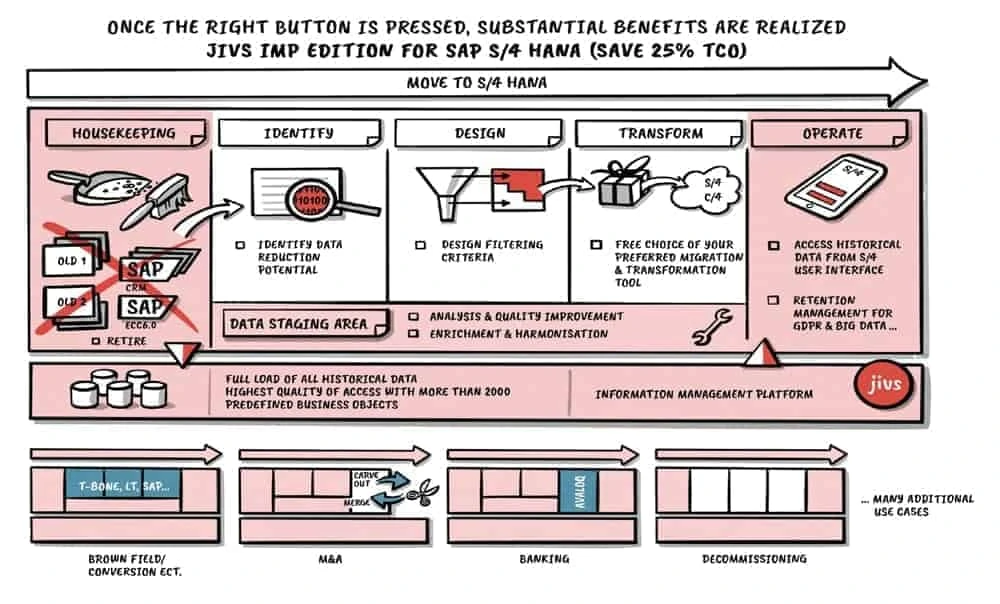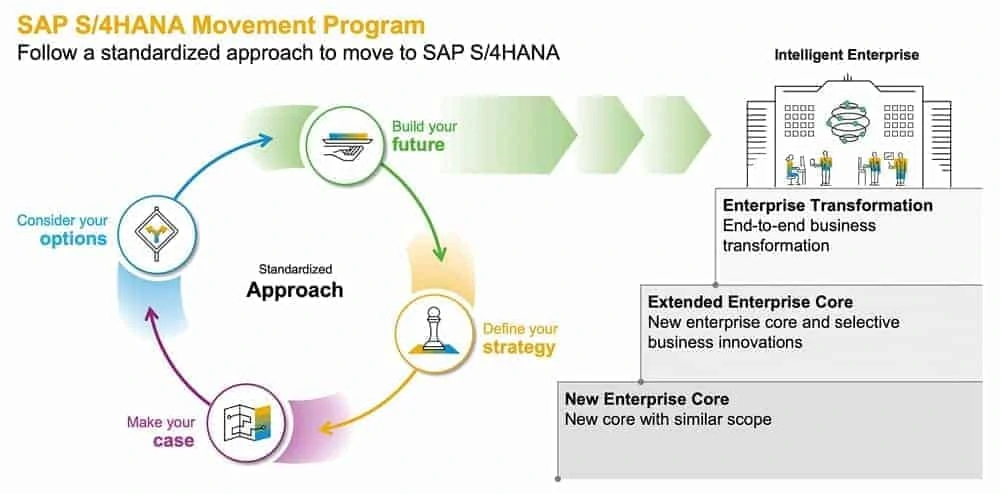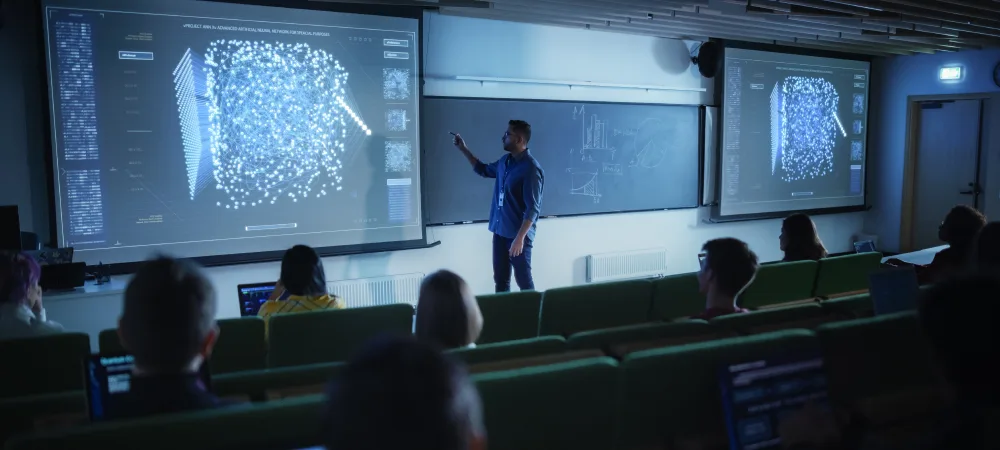Data During the Move to SAP S/4 Hana: Fuel or Ballast?


The SAP S/4 Hana transformation encompasses far more than just technology. The new software generation is the key to a company’s long-term success.
Companies need an intelligent ERP system acting as core of their IT landscape to be able to tackle digitalization challenges, to establish new data-driven business models and processes, and to ride the ever-growing tidal wave of new data rather than succumb to it.
The implementation of the new software generation and the migration and transformation project consist of many technological aspects but are primarily about strategic and organizational topics.
Choosing a migration strategy, planning how the future IT landscape will look and which processes it will support, deciding on what to do with data and documents from legacy systems—every choice in the process decides the role and importance of the future IT landscape for business and corporate strategy.
Mapping your journey to SAP S/4 Hana
Or, as the guideline “Mapping Your Journey to SAP S/4 Hana” adequately explains, “[…] the way you set up and manage your project will determine your ability to turn SAP’s innovations into your company’s advantage […] if it will provide the business agility and speed to outplay the competition through the full automation of business processes.”
To help customers in their migration journeys, SAP has established the SAP S/4 Hana Movement program under Bjoern Braemer’s leadership.

Serving as a guide for planning and projects, it offers practical tips, helpful tools, numerous services and guidelines.
Irrespective of a customer’s chosen transition path, Move defines four main phases in the journey to S/4 Hana:
The first phase is designated to choosing and defining a migration strategy. SAP supports customers with programs and events for connecting, networking and discussing ideas and experiences. One such event is Move in Motion. It also offers a card game which shows value creation potentials in S/4 for different departments and industries; simulations that help customers understand different choices and their consequences; and workshops on different topics.
All of these offer customers a precise overview of the value they can unlock for their businesses and which strategic questions they need to answer first, like:
Will existing business processes be able to support corporate strategies in the long term? Would it be better to optimize and adapt them in S/4? Are consolidation of the IT landscape and process harmonization part of project goals? Will all data and documents be migrated to the new systems or just parts of them?
For decision-makers in IT and other departments to be able to determine the right strategy for companies, they need to consider the importance of data in the future. They need to familiarize themselves with future business scenarios and the most important technologies. The Internet of Things, Big Data and the separation of historic and operational data are essential topics in this context.
The subsequently gained knowledge directly influences decisions pertaining to migration approach and implementation method, process design and management of legacy information. Intelligent enterprises need both an intelligent ERP system as well as an intelligent data management, after all.
Readiness and transformation
Answers to strategic questions are given in the second phase, which primarily consists of defining a tangible business case. This phase is important for aligning business and IT strategy so that everyone is on the same page and strategic goals can be met more easily.
Tools like SAP Readiness Check and SAP Transformation Navigator or an online recommendation service which calculates the performance of existing processes and the inherent value, can help.
Furthermore, it is equally important to find and select data and documents not needed in daily operations anymore after the migration to S/4 Hana (tools can help here as well). Besides aligning business and IT strategy, companies also need to evaluate migration costs and subsequent efforts.
However, costs are not only influenced by the choice of implementation approach—whether that might be system conversion, a completely new implementation or a mixture of both.
Costs are also affected by the choice of how many of the existing data and documents will be transferred to S/4 Hana.
Consider your options
Which of these options an individual customer will take needs to be decided in the third phase which SAP calls “Consider Your Options”. If customers decide to only migrate parts of their overall information assets, they can reduce migration efforts and duration of system downtimes during migration by using the right tools.
Build Your Future
The fourth phase is called “Build Your Future” and kind of completes the circle. It furthermore leads to a continuous optimization cycle.
The implementation of S/4 can only act as a foundation for the future—an innovative and intelligent foundation, though, answering the following questions:
Have all goals set for the migration and transformation been met? Can new processes be flexibly adapted to changes in corporate strategy or new market trends? Are IT staff able to extract information and insights from data, thus advancing business, unlocking value and eventually establishing a new business model? Is the IT landscape able to quickly and flexibly support agile scenarios like mergers and acquisitions? Will the transferred data act as fuel in the long term or will it eventually turn into ballast, hindering agility and wasting precious resources? Is the new IT landscape able to support operational cost reduction in the long term to ensure more investment capacity for innovation in the future?
It is not sufficient to answer these questions only once, however. They need to be answered again and again to ensure that companies stay on the right track.
The four phases defined in Move are therefore not only helpful before and during the migration, but also after the fact, serving as a guide for maintenance and development of S/4 Hana environments.
Irrespective of the migration approach that customers choose—whether they decide on a system conversion, a new implementation, or selective data migration and transformation—the existing legacy data and documents play a key role in the decision-making process.
SAP therefore recommends for customers to decide on the extent of data migration “as soon as possible”.

Agility versus stability
This recommendation doesn’t just pertain to the S/4 migration per se, however. After all, companies are operating in a very dynamic environment. In many industries, pursuing current business initiatives are prioritized over implementing a new software generation. Therefore, business priorities directly influence IT priorities, requiring them to adapt and develop if need be.
All of these different and sometimes even contradictory goals and priorities relevant for phase one and two of the Move program have to be considered at the same time. Companies furthermore have to keep in mind that IT budgets only increase moderately, if at all. They consequently have to find new ways to reduce the amount of resources, time and effort spent on daily IT operations.
The distinction SAP makes in its guideline for S/4 Hana migration between open processes and operational data on the one hand and historic data on the other is showing customers the right way. The document states that, “Like a race car driver, you need to understand when this data is fuel and when it’s ballast.”
Historical data
Historic data are defined as completed transactional data as well as completed and fully paid sales and maintenance contracts or orders. Furthermore, historic data encompass documents like delivery notes even if they only pertain to part of the overall delivery, meaning the order itself has not been completed yet.
For legal reasons, these historic data have to remain immutable. If users can only access them with read-only privileges, however, it doesn’t make much sense to migrate them to the new software landscape.
Historic data therefore need stability. Migration to S/4 Hana with complete or selective data migration, agile business scenarios, long-term reduction of operational costs—in all of these cases, the dictated immutability of historic data poses the question of what will happen to legacy systems.
Continuing to operate them increases costs. Because data have to be stored with their corresponding business context, traditional data archiving solutions are not enough.
Stability and legacy systems
The question of what to do with legacy systems stays relevant regardless of which migration path companies choose, because the challenge of data stability is universal.
Furthermore, the approach of selective data migration threatens to increase project costs for S/4 Hana migrations. In its migration guide, SAP is emphasizing this fact as well—a fact that remains true unless the historic data can somehow be extracted from legacy systems and stored immutably and accessibly in a cost-efficient environment. Only then can legacy systems be completely decommissioned.
This option would open up new possibilites in phase three of the Move program. Experience shows that operational costs can generally be reduced by 80 percent compared to the continued operation of legacy systems. These savings are to be set off against the additional expenditure for the data selection during the migration to S/4. This additional expenditure can even be turned into a net saving. Prerequisite is the mostly automated data transfer from legacy systems.
Furthermore, the selection criteria for transferring the selected data need to be created and relayed in a format that the SAP Migration Cockpit can read. The format also needs to be compatible with tools of the provider group called “SAP S/4 Hana Selective Data Transition Engagement”. If these requirements have been met, the data migration effort can be cut in half.
Reducing operational and migration costs is just one benefit of decommissioning legacy systems, however.
Transferring historic data to their own environment also supports the aforementioned agile use cases and business scenarios. Consolidation and harmonization projects concerning applications and subsidiaries can be accelerated and simplified.
IT staff is also able to more quickly and cost-efficiently tackle mergers and acquisitions because they can decommission acquired systems and third-party solutions as well as quickly extract data that buyers need in a neutral format.
Furthermore, a separate environment for historic data is able to support optimization of data quality and ensure that only clean and complete data sets are transferred to the new environment or software generation.
A separate environment for historic data also ensures legal certainty if the data stored within are subject to rigorous retention management. The requirements of the European General Data Protection Regulation (EU GDPR) then seem less daunting concerning historic data.
Such an environment can also become part of the new system environment with S/4 at the core. If historic data is continuously and automatedly transferred to the new environment, operating systems stay lean and agile in the long term, which positively influences total operating costs.
Moreover, the historic data remain 100 percent accessible and consequently allow an overview of business information and history with e.g. customers or suppliers. This leads to better and sometimes even completely new business insights.
Fuel for continuous optimization
The aforementioned solution for selective data migration in S/4 Hana transformation projects supports all phases of SAP’s Move program. Furthermore, the value the solution unlocks can be integrated in a continuous optimization cycle for long-term benefits.
This approach and the platform for information management behind it, JiVS IMP, have proven themselves in over 1,000 projects worldwide.
Certified by auditors, the newest generation of the platform is available in special SAP editions that support the Move program in all its phases, both in technological and business aspects. This way, historic data always act as fuel and never as ballast.









